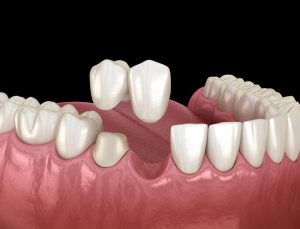Please note that we may not offer this service at our Kirkland dental office. Call (425) 284-0515.
Bridging the Gap Creatively: Your Guide to Cantilever Dental Bridges
While traditional dental bridges offer a fantastic solution by anchoring to teeth on both sides of a gap, what happens when there’s only a tooth available on one side? This is where the ingenuity of a cantilever dental bridge shines.
Connect with Dr. Roberts’ office today at (425) 284-0515. We welcome patients from Bellevue, Redmond, and Sammamish, offering a supportive and caring environment for all your dental needs.
Why Choose Your Local Kirkland Dental Office for Tooth Bridges?
Choosing a local dentist means building a long-term partnership. Dr. Roberts and our team become familiar with your unique oral health, allowing for proactive and preventive care. This bond builds trust and open communication, so you always feel comfortable discussing your dental needs.
Ready to enhance your smile with tooth bridges? Call our Kirkland, WA office today at (425) 284-0515 to schedule your consultation!
What Are Cantilever Dental Bridges?
Unlike a conventional dental bridge that relies on abutment teeth (anchor teeth) on both sides of the missing tooth space, a cantilever dental bridge is supported by only one natural tooth or dental implant. Imagine a diving board extending out from a single support point – that’s the basic principle. The artificial tooth (pontic) of the bridge “cantilevers” or extends into the space, held securely by a crown or crowns cemented onto the single supporting tooth.
The Cantilever Dental Bridge Process
Abutment Tooth Preparation
Dr. Roberts will carefully prepare the single supporting tooth. This involves reshaping the tooth by removing a small amount of enamel to create space for the bridge. Local anesthesia will be used to ensure your comfort throughout this process. This preparation is a crucial step in ensuring the cantilever bridge fits securely and functions effectively.
Taking Impressions
Precise impressions of your prepared tooth and the surrounding area are taken. These highly accurate molds are then sent to a dental laboratory. These impressions are crucial for the creation of a custom-made bridge that perfectly fits your mouth and matches the color and shape of your existing teeth. Cantilever bridges are often made of ceramic and metal or entirely of ceramic material, ensuring durability and a natural appearance.
Temporary Bridge Placement
While your permanent cantilever bridge is being meticulously crafted in the dental lab, Dr. Roberts may place a temporary bridge. This temporary prosthetic helps protect the prepared tooth, maintains the space for the replacement tooth, and allows you to continue chewing and speaking relatively normally.
Permanent Bridge Placement
Once your custom cantilever bridge arrives back at Dr. Roberts’ office in Kirkland, you’ll return for the final placement. The temporary bridge is removed, and the area is thoroughly cleaned. Dr. Roberts will carefully fit the permanent bridge, checking its alignment, ensuring a comfortable bite, and verifying its aesthetic appeal. The dentist will also ensure that the fit of the bridge is comfortable and that your bite is properly aligned after bonding.
 Candidacy for Cantilever Dental Bridges
Candidacy for Cantilever Dental Bridges
Determining if a cantilever dental bridge is the right solution for you requires a thorough evaluation by a qualified dentist like Dr. Roberts. While they offer a unique advantage, such as requiring only one adjacent tooth, they’re not suitable for every situation. Several factors contribute to ideal candidacy:
- Location of the Missing Tooth: The most common and suitable scenario for a cantilever bridge is when a tooth is missing at the very end of a dental arch, and there is no tooth behind the gap to serve as a second anchor.
- Strength and Health of the Abutment Tooth: The single tooth chosen to support the cantilever bridge must be exceptionally strong and healthy. This tooth will bear the chewing forces that would typically be shared by two abutment teeth in a conventional bridge.
- Bite Forces and Occlusion: The way your upper and lower teeth come together (your bite or occlusion) is a significant factor. If the cantilevered tooth will be subjected to very heavy chewing forces, or if you have a bite that puts unusual stress on certain areas, a cantilever bridge might not be the most durable long-term solution.
- Oral Hygiene Commitment: Patients receiving a cantilever bridge must be committed to excellent oral hygiene. The area around the supporting tooth and under the pontic (the artificial tooth that extends out) requires diligent cleaning to prevent plaque buildup, decay, and gum disease.
Dr. Roberts will conduct a comprehensive examination, including X-rays and possibly 3D imaging, to determine if you are a good candidate for a cantilever dental bridge at our Kirkland office. Call (425) 284-0515 to schedule your appointment.
Benefits of Cantilever Dental Bridges
When a patient is a suitable candidate, cantilever dental bridges offer several distinct advantages, making them a valuable option for tooth replacement:
- Fixed Tooth Replacement When Other Options Are Limited: The primary benefit of a cantilever bridge is its ability to replace a missing tooth when a traditional bridge isn’t feasible because there’s only one healthy tooth adjacent to the gap, particularly at the end of a dental arch.
- Preservation of Healthy Teeth (in Specific Cases): In certain situations, a cantilever bridge may allow Dr. Roberts to avoid preparing a second perfectly healthy tooth for a crown.
- Natural Appearance and Feel: Like traditional bridges, cantilever bridges are custom-made to match the color, shape, and size of your existing natural teeth.
- Prevents Teeth Shifting: A cantilever bridge fills this gap, helping to maintain the proper spacing and alignment of your remaining natural teeth, preserving your bite and preventing further orthodontic issues. Replacing missing teeth promptly is essential to prevent other teeth from shifting into the gap, which could lead to further complications.
Living with Your Cantilever Bridge: Care and Considerations
A cantilever bridge, like any dental restoration, requires proper care to ensure its longevity and maintain your oral health.
- Rigorous Oral Hygiene: Because the pontic is only supported on one side, meticulous cleaning around the bridge and the single abutment tooth is paramount. Brush twice daily, and use a floss threader or water flosser to clean thoroughly under the pontic and around the crown.
- Dietary Awareness: While cantilever bridges are strong, they are designed to withstand forces primarily from one side. Dr. Roberts may advise you to be mindful of chewing extremely hard or sticky foods directly on the cantilevered tooth, as excessive forces could potentially stress the supporting tooth or the bridge itself.
- Regular Dental Check-ups: Consistent visits to Dr. Roberts for professional cleanings and examinations are crucial. These routine visits are an investment in the long-term success of your cantilever bridge.
Frequently Asked Questions
A traditional bridge is supported by natural teeth on both sides of the missing tooth gap. A cantilever bridge, however, is supported by only one natural tooth or implant on one side of the gap, with the artificial tooth (pontic) extending out into the space.
Cantilever bridges can be very strong and successful when placed in the right situations and with careful planning. However, because they are supported on only one side, they may experience different stresses than traditional bridges. Dr. Roberts carefully assesses if your bite and the supporting tooth are suitable for this type of bridge.
The primary advantage is that a cantilever bridge provides a fixed tooth replacement when there’s no supporting tooth available on one side of the gap, especially for teeth at the very back of the mouth. It also avoids needing to prepare a second healthy tooth if only one is required for support.
Caring for a cantilever bridge involves diligent oral hygiene to prevent tooth decay, including brushing twice daily and using a floss threader or water flosser to clean thoroughly under the pontic. Regular dental check-ups with Dr. Roberts are also essential to monitor the bridge and the supporting tooth.
Restore Your Complete Smile with Our Nearby Dentist, Dr. Roberts
Has a missing tooth, especially one at the end of your dental arch, left you feeling uncertain about your options? Our Kirkland dental office is dedicated to exploring every innovative approach, including cantilever bridges, to help you achieve the confident, comfortable smile you envision.
From Bellevue to Redmond and Sammamish, we invite you to experience a compassionate and forward-thinking approach to your oral health. Call us today at (425) 284-0515 to schedule your consultation. Let’s design your ideal smile solution, together.
 Candidacy for Cantilever Dental Bridges
Candidacy for Cantilever Dental Bridges